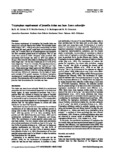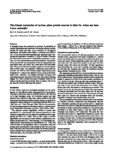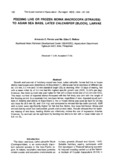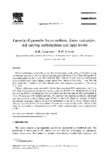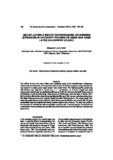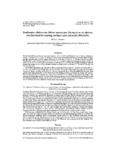Search
Now showing items 1-10 of 13
Tryptophan requirement of juvenile Asian sea bass Lates calcarifer
(Blackwell Publishing, 2004)
The dietary requirement of tryptophan for juvenile Asian sea bass (Lates calcarifer Bloch) was studied. The juveniles (mean initial weight, 5.30 ± 0.06 g) were given semi-purified test diets containing fish ...
Daily amount of rotifers taken by a sea bass Lates calcarifer larvae
(Science and Technology Information Institute, 1990)
The amount of rotifers consumed by a single sea bass Lates calcarifer larva per day (R) was examined by both the direct and by the satiation-digestion methods. In the direct method, R is estimated by the number of rotifers ...
Nutritional evaluation of various plant protein sources in diets for Asian sea bass Lates calcarifer
(Wiley-Blackwell, 2000)
A biological assay was conducted to evaluate the suitability of various leguminous seed meals and leaf meals as dietary protein sources for Asian sea bass, Lates calcarifer. In the growth experiment, fish (initial mean ...
Feeding live or frozen Moina macrocopa (Strauss) to Asian sea bass, Lates calcarifer (Bloch), larvae
(Society of Israeli Aquaculture and Marine Biotechnology, 1994)
Growth and survival of hatchery-reared sea bass, Lates calcarifer, larvae fed live or frozen Moina macrocopa were determined, In Experiment 1, Moina was fed to sea bass of different sizes: 3.6 mm, 5.5 mm and 7.6 mm standard ...
Growth of juvenile Asian seabass, Lates calcarifer, fed varying carbohydrate and lipid levels
(Elsevier, 1997)
Growth performance of juvenile seabass (initial mean body weight, 0.90 ± 0.04 g) fed varying carbohydrate and lipid levels were determined using practical diets in a 2 × 3 factorial experiment. Two carbohydrate levels (15 ...
Netcage rearing of the Asian seabass Lates calcarifer (Bloch) in brackishwater pond: The technical and economic efficiency of using high protein diets in fingerling production
(College of Agriculture, University of the Philippines Los Baños, 2012)
Intensification in the grow-out culture of high-value fish requires a large quantity of quality fingerlings. Fingerling production is a component of fish farming that comprises nursery and grow-out culture, and may be a ...
Use of juvenile instar Diaphanosoma celebensis (Stingelin) in hatchery rearing of Asian sea bass Lates calcarifer (Bloch)
(Society of Israeli Aquaculture and Marine Biotechnology, 2001)
The effects of size, dry mass intake and nutritional value of the brackishwater cladoceran, Diaphanosoma celebensis, on the growth and survival of 15-30 day sea bass (Lates calcarifer) larvae reared in a static green water ...
Freshwater cladoceran Moina macrocopa (Strauss) as an alternative live food for rearing sea bass Lates calcarifer (Bloch) fry
(Blackwell Publishing, 1991)
Fifteen day old sea bass larvae were acclimated to 10‰ S and fed ad libitum levels of Moina, Artemia or Moina + Artemia (at 1:1 ratio). Fish kept at 32 ‰ S and fed Artemia served as a control. After 20 days, specific growth ...
Effect of dietary lipid sources on growth, survival and fatty acid composition of sea bass (Lates calcarifer, Bloch) fry
(Society of Israeli Aquaculture and Marine Biotechnology, 1991)
Soybean oil, cod liver oil and coconut oil were tested singly or in combination (1:1) as a source of dietary lipid for sea bass fry. Growth and survival rates of fry fed a diet containing cod liver oil and soybean oil (1:1 ...
Effect of delayed feeding of Artemia salina and partial replacement by Moina macrocopa on growth and survival of sea bass, Lates calcarifer (Bloch), larvae.
(Society of Israeli Aquaculture and Marine Biotechnology, 1994)
One-day old sea bass larvae (0.93-2.03 mm total length, 0.94-1.00 mg wet body weight) were stocked at a density of 30 larvae per liter in nine 250 l capacity fiberglass tanks. Fish were reared for 26 days on three different ...

